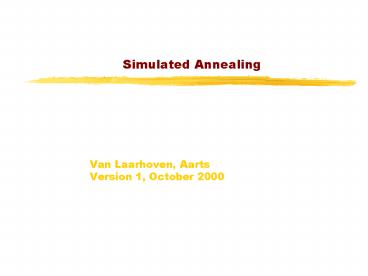Simulated Annealing - PowerPoint PPT Presentation
Title:
Simulated Annealing
Description:
Simulated Annealing Van Laarhoven, Aarts Version 1, October 2000 Iterative Improvement 1 General method to solve combinatorial optimization problems Principle: Start ... – PowerPoint PPT presentation
Number of Views:77
Avg rating:3.0/5.0
Title: Simulated Annealing
1
Simulated Annealing
- Van Laarhoven, AartsVersion 1, October 2000
2
Iterative Improvement 1
- General method to solve combinatorial
optimization problems - Principle
- Start with initial configuration
- Repeatedly search neighborhood and select a
neighbor as candidate - Evaluate some cost function (or fitness function)
and accept candidate if "better" if not, select
another neighbor - Stop if quality is sufficiently high, if no
improvement can be found or after some fixed time
3
Iterative Improvement 2
- Needed are
- A method to generate initial configuration
- A transition or generation function to find a
neighbor as next candidate - A cost function
- An Evaluation Criterion
- A Stop Criterion
4
Iterative Improvement 3
- Simple Iterative Improvement or Hill Climbing
- Candidate is always and only accepted if cost is
lower (or fitness is higher) than current
configuration - Stop when no neighbor with lower cost (higher
fitness) can be found - Disadvantages
- Local optimum as best result
- Local optimum depends on initial configuration
- Generally no upper bound on iteration length
5
Hill climbing
6
How to cope with disadvantages
- Repeat algorithm many times with different
initial configurations - Use information gathered in previous runs
- Use a more complex Generation Function to jump
out of local optimum - Use a more complex Evaluation Criterion that
accepts sometimes (randomly) also solutions away
from the (local) optimum
7
Simulated Annealing
- Use a more complex Evaluation Function
- Do sometimes accept candidates with higher cost
to escape from local optimum - Adapt the parameters of this Evaluation Function
during execution - Based upon the analogy with the simulation of the
annealing of solids
8
Other Names
- Monte Carlo Annealing
- Statistical Cooling
- Probabilistic Hill Climbing
- Stochastic Relaxation
- Probabilistic Exchange Algorithm
9
Analogy
- Slowly cool down a heated solid, so that all
particles arrange in the ground energy state - At each temperature wait until the solid reaches
its thermal equilibrium - Probability of being in a state with energy E
- Pr E E 1/Z(T) . exp (-E / kB.T)
- E Energy
- T Temperature
- kB Boltzmann constant
- Z(T) Normalization factor (temperature dependant)
10
Simulation of cooling (Metropolis 1953)
- At a fixed temperature T
- Perturb (randomly) the current state to a new
state - ?E is the difference in energy between current
and new state - If ?E lt 0 (new state is lower), accept new state
as current state - If ?E ? 0 , accept new state with probability
- Pr (accepted) exp (- ?E / kB.T)
- Eventually the systems evolves into thermal
equilibrium at temperature T then the formula
mentioned before holds - When equilibrium is reached, temperature T can be
lowered and the process can be repeated
11
Simulated Annealing
- Same algorithm can be used for combinatorial
optimization problems - Energy E corresponds to the Cost function C
- Temperature T corresponds to control parameter c
- Pr configuration i 1/Q(c) . exp (-C(i)
/ c) - C Cost
- c Control parameter
- Q(c) Normalization factor (not important)
12
Homogeneous Algorithm
- initialize
- REPEAT
- REPEAT
- perturb ( config.i ? config.j, ?Cij)
- IF ?Cij lt 0 THEN accept
- ELSE IF exp(-?Cij/c) gt random0,1) THEN
accept - IF accept THEN update(config.j)
- UNTIL equilibrium is approached sufficient
closely - c next_lower(c)
- UNTIL system is frozen or stop criterion is
reached
13
Inhomogeneous Algorithm
- Previous algorithm is the homogeneous variant
- c is kept constant in the inner loop and is only
decreased in the outer loop - Alternative is the inhomogeneous variant
- There is only one loop c is decreased each time
in the loop, but only very slightly
14
Parameters
- Choose the start value of c so that in the
beginning nearly all perturbations are accepted
(exploration), but not too big to avoid long run
times - The function next_lower in the homogeneous
variant is generally a simple function to
decrease c, e.g. a fixed part (80) of current c - At the end c is so small that only a very small
number of the perturbations is accepted
(exploitation) - If possible, always try to remember explicitly
the best solution found so far the algorithm
itself can leave its best solution and not find
it again
15
Markov Chains 1
- Markov Chain
- Sequence of trials where the outcome of each
trial depends only on the outcome of the previous
one - Markov Chain is a set of conditional
probabilities - Pij (k-1,k)
- Probability that the outcome of the k-th trial
is j, when trial k-1 is i - Markov Chain is homogeneous when the
probabilities do not depend on k
16
Markov Chains 2
- When c is kept constant (homogeneous variant),
the probabilities do not depend on k and for each
c there is one homogeneous Markov Chain - When c is not constant (inhomogeneous variant),
the probabilities do depend on k and there is one
inhomogeneous Markov Chain
17
Performance
- SA is a general solution method that is easily
applicable to a large number of problems - "Tuning" of the parameters (initial c, decrement
of c, stop criterion) is relatively easy - Generally the quality of the results of SA is
good, although it can take a lot of time - Results are generally not reproducible another
run can give a different result - SA can leave an optimal solution and not find it
again(so try to remember the best solution found
so far) - Proven to find the optimum under certain
conditions one of these conditions is that you
must run forever































